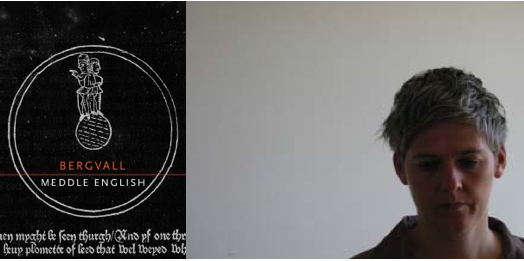A review of 'Meddle English'

Meddle English: New and Selected Texts includes a broad range of texts that vary in texture and rhetorical means. Texts range from an engaging essay on the history and future of English (and language in general) to an essay on language as personally experienced by the author; from deft poetic trans-creations of Chaucer’s Middle English to blueprints, or sight-maps, for performance poetry; and from textual art and to visual art. A rare bounty of textuality, and for Bergvall this variety is intentional; she believes that the situation of contemporary poetry demands such resourcefulness: “Poetic art becomes an occupancy of language made manifest through various platforms, a range of instrumental tools and skills and relativized forms of inscription” (15–6).
Bergvall knows no fewer than three recognizable languages (English, French and Norwegian are on display here), and her personal history and current life, growing up in a handful of countries and now widely touring Europe and beyond as a poet, are also expressive of cultural and practical complexity. This book argues that this sort of interstitial, diasporic, multi-tiered living and thinking is personally salubrious, culturally necessary and a model for being in time to come. The word “meddle” signifies how language and experience, self-consciously activated, must combine to exert a pressure on individual and collective consciousness: “The meddle is collective awareness. Denaturalization of one’s personal and cultural premise. Getting lost. Physical and mental effort. New apprenticeship and transformed commitment” (19).
Her desire is to uncover language to show not only the prejudices of current and traditional discourse models (both poetic and ratio-logical) but also to show how language, at a fundamental level, impacts your body. She writes elsewhere that “[f]or a long time, I’ve been working out of pressure points, awkward grammatical and cultural units that force up questions about linguistic belonging, bodyshape, the communal bonds or binds or bounds that lodge within my own make-up” (Feminaissance, 68). She means to delve into the middens — the refuse — the material that would otherwise be looked over because not part of the structure of meaning — and investigate these odd remains.
This sense of mission shows itself everywhere in her prose: “It is the writer’s role to test out, provoke the naturalized edges and bounds of language use and rules. She mines language for what is always moving, always escaping. To travel at the heels of writing activates reclaiming zones, fictitious collective memory” (17). It is an exciting project, and her intention carries over into her poetic texts. Take, for instance, the beginning of the “Fried Tale (London Zoo)”:
All juicit with an arseful of moola, wonga, clams & squids
doks stasht in identikl blakases hanging from ther hans
2 Suits, a mega pair of Smith, Blupils no dout,
viddying how they trading outa goodness welth stuporifik […] (38)
While it’s difficult to say what such deformations of standard, written English can produce in the way of a sharable idiom, this strategy does certainly remind us that any notion of standard comes fraught with questions of political agency and oppression: Whose English is standard? What are the consequences of a super-valuation of written speech over oral? How does a person separate themselves from the stigmas, and the ideologies, of any language?
Her interest in finding a way to be right within wrongness, natural within unnaturalness, comes with its material themes: spit and shit; phlegm and food. This creates situational irony: poetry, the once-upon-a-time elevated rhetoric of the wise, turns into a jaunty (Chaucerian) romp through the Seven Deadly Sins and those bodily and sexual issues that can be reliably counted on to offend propriety:
MOTion
begs out of
g
GA
g
ging
Dis
g
orging
b
loo*
p
uke
s
uck
ack
ock
s
OG
ex
Creme
ental [....] (“Goan Atom,” 94)
This infringement of the body upon the corpus of the written word (and art), most famously and egregiously implemented by Beckett, creates a paradox, itself evident above. That is, her poetry’s intentional textual errors and pre-literacy create a level of sophistication that means that in order to appreciate the textual disturbances a reader probably ought to have both a glancing familiarity with the most current varieties of art-talk and language-theory but also a recording of her reading the text to show how it’s done. (Here’s one case where it would have been nice to have a CD with the book.)
Tacked onto this paradox comes another. For a person relatively unversed in the particularities of her idiolectic, mixed languages, her poetic texts might read like computer code; but since the effort is meaningful, what of it? It points toward the last paradox, that despite her texts’ sophistication — which might seem to inaugurate strictly intellectual pleasures — when the texts enter into the reader’s ear and/or metaphorical bloodstream, the first clear pleasures are intuitive, those of sound, rhythm and cadence and the forever-alive performative dimension of speech. The delights are as alive (and personal) as language exists in the morning before you have re-coded it all into the Queen’s English, or the rational language of book-reviews, or even syntax itself.
